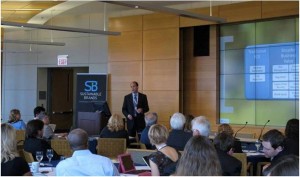When we do a ?good deed? in a personal relationship do we assign a value to that good deed? Sure, there?s the unwritten social contract of ?pay it forward,? but we don?t really keep a balance sheet of how many unselfish acts we perform for friends or family ? or do we?
When the ratio of giving vs. receiving gets too far out of whack, the giving may feel harder to justify. Most businesses face a similar dilemma. How do they justify the costs of doing environmentally and socially responsible good deeds, of operating sustainably, if they can?t measure what they?ll get back in return? This was the fundamental question that we sought to answer during The New Metrics of Sustainable Business Conference?at the University of Pennsylvania?s The Wharton School in September.

Robert Boller, VP Sustainability Kendall-Jackson
I was there to present Kendall-Jackson?s case study of how our sustainability program delivers business value. On its face it seems simple, but the tricky part is quantifying the benefits in the language of business ? dollars and cents. In fact, many of the most important outcomes from demonstrating sustainability leadership are the hardest to measure financially.
Sure, it?s easy enough to measure the financial value of conserving energy, but what about our employee sustainability education program? It?s much harder to measure, in business terms, the value of teaching employees how to save energy and money in their homes.
We expected benefits like increased employee morale, which can lead to reduced turnover; and being a responsible company can attract top talent. We?ve recently had employees join Kendall-Jackson in part because of our sustainability program, but it remains difficult to put a dollar figure on these intangible benefits.

Paul Herman, HIP Investing
Paul Herman, of HIP Investor, highlighted that today these intangible assets make up 80% of the market value for the S&P 500. That means that people truly are a company?s greatest asset?because they create most of the market value like reputation, brand value, patents and intellectual property. This is a reversal from the 20th century when most of a company?s value was attributed to physical assets like land, production plants and equipment.
KoAnn Skrzyniarz, CEO of Sustainable Life Media, opened the conference with an insight: ?Sustainability is going to be the fundamental opportunity for business innovation in the 21st century.” For two days academic and business leaders discussed new ways to justify sustainability programs beyond just doing the right thing.
For me it was very rewarding that the Kendall-Jackson case study was one of the most popular presentations. We talked about the benefit of transforming from a company that does sustainable things to having a culture of sustainability. That by educating all employees and encouraging them to get involved we?ve achieved business benefits that were unexpected and we couldn?t have foreseen. Even if we can?t assign a dollar amount to each of these benefits, it?s pretty obvious that doing the right thing is best for the environment, society and our bottom-line.
Even after the conference I?m still thinking about the profound question that was posed by Gil Friend, CEO of Natural Logic Inc, ?Is life in the service of business or is business in the service of life?? Each of us can answer that question for ourselves, but rest assured many of us are working hard to prove that being environmentally and socially responsible is the path to success for business and life in the future.

